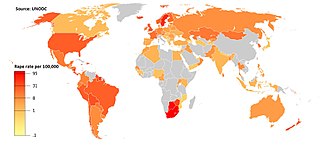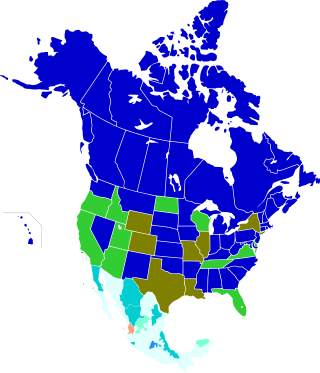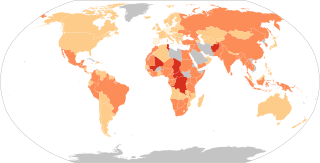Related Research Articles
Sexual assault is an act in which one intentionally sexually touches another person without that person's consent, or coerces or physically forces a person to engage in a sexual act against their will. It is a form of sexual violence that includes child sexual abuse, groping, rape, drug facilitated sexual assault, and the torture of the person in a sexual manner.
Some victims of rape or other sexual violence incidents are male. It is estimated that approximately one in six men experienced sexual abuse during childhood. Historically, rape was thought to be, and defined as, a crime committed solely against females. This belief is still held in some parts of the world, but rape of males is now commonly criminalized and has been subject to more discussion than in the past.
Sexual violence is any harmful or unwanted sexual act—or attempt to obtain a sexual act through violence or coercion—or an act directed against a person's sexuality without their consent, by any individual regardless of their relationship to the victim. This includes forced engagement in sexual acts, attempted or completed, and may be physical, psychological, or verbal. It occurs in times of peace and armed conflict situations, is widespread, and is considered to be one of the most traumatic, pervasive, and most common human rights violations.

Rape culture is a setting, as described by some sociological theories, in which rape is pervasive and normalized due to that setting's attitudes about gender and sexuality. Behaviors commonly associated with rape culture include victim blaming, slut-shaming, sexual objectification, trivializing rape, denial of widespread rape, refusing to acknowledge the harm caused by sexual violence, or some combination of these. It has been used to describe and explain behavior within social groups, including prison rape and in conflict areas where war rape is used as psychological warfare. Entire societies have been alleged to be rape cultures.

In North America, the legal age of consent relating to sexual activity varies by jurisdiction.
Rape is a type of sexual assault initiated by one or more persons against another person without that person's consent. The act may be carried out by physical force, under threat or manipulation, by impersonation, or with a person who is incapable of giving valid consent.
Rape can be categorized in different ways: for example, by reference to the situation in which it occurs, by the identity or characteristics of the victim, and by the identity or characteristics of the perpetrator. These categories are referred to as types of rape. The types described below are not mutually exclusive: a given rape can fit into multiple categories, by for example being both a prison rape and a gang rape, or both a custodial rape and the rape of a child.
Statistics on rape and other acts of sexual assault are commonly available in industrialized countries, and have become better documented throughout the world. Inconsistent definitions of rape, different rates of reporting, recording, prosecution and conviction for rape can create controversial statistical disparities, and lead to accusations that many rape statistics are unreliable or misleading.

Rape is a type of sexual assault involving sexual intercourse or other forms of sexual penetration carried out against a person without their consent. The act may be carried out by physical force, coercion, abuse of authority, or against a person who is incapable of giving valid consent, such as one who is unconscious, incapacitated, has an intellectual disability, or is below the legal age of consent. The term rape is sometimes used interchangeably with the term sexual assault.
Sexual violence refers to a range of completed or attempted sexual acts in which the affected party does not or is unable to consent. Theories on the causes of sexual violence are numerous and have come out of many different disciplines, such as women's studies, public health, and criminal justice. Proposed causes include military conquest, socioeconomics, anger, power, sadism, traits, ethical standards, laws, and evolutionary pressures. Most of the research on the causes of sexual violence has focused on male offenders.
In common law jurisdictions, statutory rape is nonforcible sexual activity in which one of the individuals is below the age of consent. Although it usually refers to adults engaging in sexual contact with minors under the age of consent, it is a generic term, and very few jurisdictions use the actual term statutory rape in the language of statutes. In statutory rape, overt force or threat is usually not present. Statutory rape laws presume coercion because a minor or mentally disabled adult is legally incapable of giving consent to the act.
Sexual consent is consent to engage in sexual activity. In many jurisdictions, sexual activity without consent is considered rape or other sexual assault.
Rape in the United States is defined by the United States Department of Justice as "Penetration, no matter how slight, of the vagina or anus with any body part or object, or oral penetration by a sex organ of another person, without the consent of the victim." While definitions and terminology of rape vary by jurisdiction in the United States, the FBI revised its definition to eliminate a requirement that the crime involve an element of force.
Marital rape is illegal in all 50 US states, though the details of the offence vary by state.

Sexual violence means that someone forces or manipulates someone else into unwanted sexual activity without their consent. Such violence can take place in both heterosexual and homosexual relationships, as well as outside intimate relationships. All sexual offenses violate the basic right of sexual self-determination. In Finland, sexual violence and taking advantage of a person is always a crime, even if the assaulter was the victim's spouse, relative or their friend. Sexual offences include but are not limited to rape, forcing someone into a sexual act and taking sexual advantage of a person. The victims of sexual violence are predominantly women, but 26 percent of Finnish men have experienced sexual harassment since their 15th birthday.
Rape myths are prejudicial, stereotyped, and false beliefs about sexual assaults, rapists, and rape victims. They often serve to excuse sexual aggression, create hostility toward victims, and bias criminal prosecution.
Non-consensual condom removal, or "stealthing", is the practice of a person removing a condom during sexual intercourse without consent, when their sex partner has only consented to condom-protected sex. Purposefully damaging a condom before or during intercourse may also be referred to as stealthing, regardless of who damaged the condom.
Rebecca Campbell is a professor of psychology at Michigan State University. She is known for her research pertaining to sexual assault and violence against women and children and the effects of treatment by law enforcement and medical staff on victims' psychological and physiological well-being. Campbell has been involved in criminal justice research on the investigation of Detroit's untested rape kits, wherein DNA evidence obtained in thousands of rape kits was left in storage and not analyzed. She has received numerous awards for her work including the Society for the Psychological Study of Social Issues Louise Kidder Early Career Award (2000), the American Psychological Association (APA) Early Career Award for Distinguished Contributions to Psychology in the Public Interest (2008), the APA Division 27 Council on Educational Program's Excellent Educator Award (2015), and the U.S. Department of Justice Vision 21 Crime Victims Research Award (2015).
Rape laws vary across the United States jurisdictions. However, rape is federally defined for statistical purposes as:
Penetration, no matter how slight, of the vagina or anus with any body part or object, or oral penetration by a sex organ of another person, without the consent of the victim.
Sexual consent plays an important role in laws regarding rape, sexual assault and other forms of sexual violence. In a court of law, whether or not the alleged victim had freely given consent, and whether or not they were deemed to be capable of giving consent, can determine whether the alleged perpetrator is guilty of rape, sexual assault or some other form of sexual misconduct.
References
- 1 2 3 4 5 van Minnen 2017, p. 76.
- 1 2 3 Koljonen, Camilla (15 July 2019). "How is consent-based legislation on rape providing more protection for individuals in comparison to coercion-based legislation? - Comparison between Finland and Sweden". Maastricht University . Retrieved 23 January 2022.
The coercion-based model, at least in Finland, requires that the victim must use all of their efforts and powers in order to stop the sexual attack. This means, that often when the victim is scared, the perpetrator does not have to use a lot of force in order to carry out the rape. It is possible that the victim involuntarily paralyses from fear, and thus is unable to make any efforts to stop the attack. In these cases, Finnish courts have not regarded these cases as rapes, since the perpetrator did not have to use force. In the consent-based model, on the other hand, there is no such requirement for the victim. It is sufficient for the victim to state that they did not voluntarily participate in the sexual act.
{{cite journal}}: Cite journal requires|journal=(help) - 1 2 3 4 Bracha 2004, p. 679–680.
- 1 2 van Minnen 2017, p. 15–16.
- 1 2 Möller, Anna; Söndergaard, Hans Peter; Helström, Lotti (7 June 2017). "Tonic immobility during sexual assault – a common reaction predicting post-traumatic stress disorder and severe depression". Acta Obstetricia et Gynecologica Scandinavica. 96 (8): 932–938. doi:10.1111/aogs.13174. PMID 28589545.
- 1 2 3 4 5 6 7 8 Bracha 2004, p. 680.
- 1 2 3 van Minnen 2017, p. 16.
- 1 2 3 van Minnen 2017, p. 15.
- 1 2 3 van Minnen 2017, p. 18.
- ↑ van Minnen 2017, p. 44.
- 1 2 3 4 5 6 "Een op tien vrouwelijke studenten tijdens studietijd zonder instemming gepenetreerd". ioresearch.nl. I & O Research. 9 June 2021. Retrieved 22 January 2022.
- ↑ de Haas, Stan; van Berlo, Willy; Bakker, Floor; Vanwesenbeeck, Ine (2012). "Prevalence and characteristics of sexual violence in the Netherlands, the risk of revictimization and pregnancy: results from a national population survey". Violence and Victims. 27 (4): 592–608. doi:10.1891/0886-6708.27.4.592. PMID 22978077. S2CID 40415699.
- ↑ van Minnen 2017, p. 12, 23.
- ↑ "Wetsvoorstel seksuele misdrijven". Rijksoverheid.nl. Ministry of General Affairs. 8 March 2021. Retrieved 20 April 2021.
- ↑ "Memorie van toelichting bij Wetsvoorstel seksuele misdrijven". Rijksoverheid.nl. Ministry of General Affairs. 8 March 2021. Retrieved 20 April 2021.
Invoking Istanbul Convention Article 36, Justice Minister Grapperhaus' explanatory memorandum stated: 'No means no. If this is not respected, boundaries are crossed and behaviour becomes punishable. This includes cases where 'no' is not clearly expressed, but the lack of desire of the other person should have been deduced from the externally visible facts or circumstances. The use of force, violence or threat is no longer a condition for punishability and qualification of a behaviour as sexual assault and rape, but constitutes an aggravating circumstance.'
- 1 2 Anne Grietje Franssen (20 October 2020). "In Zweden is de definitie van verkrachting breed, en dat is terug te zien in de cijfers". Trouw (in Dutch). Retrieved 22 January 2022.
...'negligent rape' and 'negligent sexual assault' (...) apply in cases in which, according to the court, there was no consent, but the perpetrator also did not have the intention to commit assault.
- ↑ van Minnen 2017, p. 112.
- ↑ van Minnen 2017, p. 84–86.